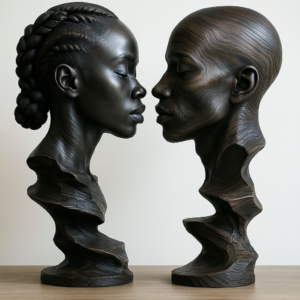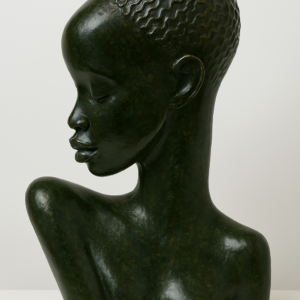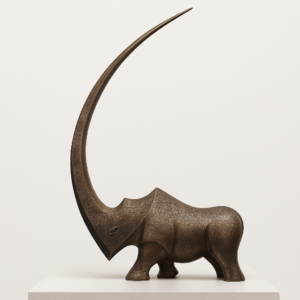Mapacha wa Urithi, meaning “Twins of Heritage” in Swahili, is a profoundly symbolic traditional African artifact—a carved ceremonial comb that transcends its utilitarian origins to become a sculptural celebration of unity, identity, and ancestral continuity. This piece is rooted in West African heritage, particularly reminiscent of the cultural practices of the Akan and Yoruba peoples, where carved combs were not only grooming instruments but sacred cultural relics of social and spiritual significance.
The comb stands tall and upright, meticulously hand-carved from a single piece of seasoned hardwood. It showcases a dual-faced motif—two serene feminine profiles set back-to-back atop the comb, their finely etched hairstyles mirroring one another in balance and symmetry. This duality suggests the theme of twinship, which in many African societies represents a cosmic pairing: dual forces of the universe, harmony between masculine and feminine energies, and even reflections of the divine. In Yoruba cosmology, for example, twins (ìbejì) are celebrated and venerated, believed to possess spiritual power.
The upper segment of the comb is crowned by the two carved heads, each with stylized almond eyes, prominent brows, sculpted cheekbones, and calm, composed lips. Their braided hairstyles speak to ancestral grooming traditions and feminine dignity, and their closed eyes reflect a meditative inner world, perhaps alluding to spiritual vision. Between the heads is a central vertical ridge—an abstracted column that could symbolize unity, connection, or the sacred spine that holds generational knowledge. The faces appear at peace, yet exude a commanding presence that makes this object resonate as a spiritual totem.
Beneath the heads, the comb expands into a broad, triangular “bridge” that stabilizes the top and anchors the structure. Adorned with deeply etched geometric motifs—especially repeating triangles and lozenges—this portion functions almost like a shield or crown, reinforcing the symbolism of protection and nobility. These patterns are not ornamental alone; they are ancestral scripts, coded with messages about rank, tribal identity, and spiritual guardianship.
The lower portion consists of seven comb teeth—each long, slender, and carefully smoothed to taper into rounded points. These are functional yet ceremonial, a testament to how African craftsmanship merges practicality with sacred meaning. In many African traditions, the number seven is spiritually significant—representing wholeness, the seven directions (north, south, east, west, up, down, and within), and the rhythm of ritual cycles.
Combs like Mapacha wa Urithi were historically gifted during rites of passage such as initiation into adulthood, marriage ceremonies, or even as offerings to ancestors. They served as extensions of identity, beauty, and status, carried with pride by women or kept as heirlooms passed from one generation to the next. A comb was a physical extension of the self—touching hair, which in African spirituality is considered the seat of the soul. Thus, this piece is not merely decorative; it is deeply personal and sacred.
The wood used in this piece is likely iroko or ebony—species prized for their hardness, durability, and spiritual symbolism. The surface has been oiled to preserve its integrity, and the patina it carries suggests age and reverent use. Despite its size, the comb maintains an elegant proportion: balanced, lightweight enough to be held, yet dense enough to command its own place on a pedestal or in a curated cultural space.
In contemporary art collections, Mapacha wa Urithi stands as a unique cross-section of sculpture, ethnography, and design. It invites conversation around African femininity, the power of twins in African cosmology, and the broader story of African artisanship passed through generations. It is especially suitable for collectors of African decorative arts, museums, or cultural galleries focused on gender, identity, or ritual symbolism.
Placing this piece in a modern space—be it a home, library, or meditation room—connects the viewer to a lineage of African beauty, intellect, and ancestral wisdom. As a symbolic artifact, it serves as a bridge between the past and the present, grounding any space in African pride, memory, and craftsmanship.





Reviews
There are no reviews yet.